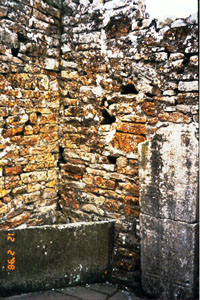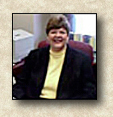
|
Kieran of ClonmacnoisSt. Kieran Mac a'tSaoir of Clonmacnois was born on February 24, 515 C.E. He was the third son of Beoit, a chariot builder and descendent of the royal line of Eremon, and Dercara, the daughter of Ercan and granddaughter of Glas, the poet. Kieran studied with Finnian at Clonnard, and was followed all the way to his teacher's by a cow and her calf, who provided milk for the entire community. According to legends, the skin of the cow was preserved as a relic at Clonmacnois. Kieran also studied with St. Enda at Aran. Here he had a vision of a huge tree in the center of Ireland, whose fruitful branches spread out to the four corners of Ireland. All the birds of the air dwelt in its branches. His teacher Enda told him that "You are the tree and all Eireann shall be filled with your name and sheltered by the grace within you. Many men from foreign lands will be fed by your prayers and fastings so go, in the name of God, and found your church on the banks of the Shannon in the center of our island." Kieran left Aran, and went to Scattery Island and St. Senan, founded a church at Isell, and then went to Inis Aingin. Here, he met and converted some of those who would help him to found Clonmacnois. One of these men, Oenna, succeeded him as abbot after his death. The Foundation and Brief History of ClonmacnoisClonmacnois, whose name means "The Meadow of the Sons of Nos," was founded by Kieran sometime around 544 or 548. The land on which it was built was given to him by Diarmuid MacCerbhaill. The remains of the community today are very different from the settlement built by Kieran, which was likely built of wood and consisted of the abbot's house with the beehive huts of Kieran's seven companions surrounding it and the church. Kieran never lived to see the community flourish, as he died at the age of thirty only seven months after the foundation from the buidhe conaill, a plague which periodically affected Ireland. When he died, Kieran told the brethren, "Go ye, let my relics bleach in the sun like the bones of a deer; better for you to dwell in heaven with me, then here with my relics." He also predicted that, "Towards the end of the world there will be a great persecution of my monastery by wicked men." He asked to be alone with his anamchara Kevin of Glendalough, and then gave Kevin the bell, the symbol of his monastic rule. The community flourished until 664, the year of the Synod of Whitby, when several members of the community died of jaundice. In the eighth century, three fires damaged the community. At this time, several prophetic events are recorded. The Annals of Clonmacnois describe two visions; one of these was "a terrible vision at Clonmancnois and great repentance throughout Ireland." Another was the appearance of the aurora borealis, which resembled ships with their men passing over Clonmacnois in 748. The prophecies were fulfilled in the ninth century, when the community was attacked five times. In 832 the King of Cashel massacred the brethren, and only ten years later the Vikings sacked the community. The wife of the Viking Chieftain Turgesius, Ota, profaned the sacred nature of the church when she uttered prophecies from the altar. During these times of crisis, the intellectual and artistic life of the community continued to flourish. Stone carving became a highly developed art form, best represented by Turcan, who carved the Cross of the Scriptures. To view some examples of the many incised crosses on Clonmacnois, click here. The monk Suibane was known throughout Europe as the most learned man of his time. His death in 890 was recorded by chronicles in many places. The community became such a revered center of learning that when the High King of Ireland, Flann, died in 915, he was buried close to the cathedral on the site marked by the Cross of the Scriptures. Flann was a benevolent patron of the community, and his death ushered in an era of disasters. In 918 the community was damaged by flooding, and the monastery was plundered three times by the Danes and six times by other groups, including the Munstermen. The number of times the community was attacked reflect its prominence as a center of learning and the wealth with which it was associated. By the eleventh century, things had returned to a calmer state, and the kings of Connaught patronized the monks and gave them protection. New construction began at Clonmancnois, and new churches and roads were built to allow better access to its various parts. New arts forms were introduced to the community, which had previously focused on stone sculpture. The monks worked with gold and silver, and the monk Mael-Muire made one of the most well-known Irish manuscripts, the Leabhar non-Uidhiri, or the Book of the Dun Cow. Its name is derived from the legend that it was written on vellum from the skin of St. Kieran's cow. Peaceful times would not last long for the community. In 1131 the Bell Tower's cap was destroyed by lightening, and ion 1149, another lightning strike damaged a yew tree believed to have been planted by Kieran himself. In 1178, the Annals of Clonmacnois record another disaster; Hugo, Constable of the King of England, plundered the entire community but for the churches. During the next year, 105 houses were burned at the community. 1198 marks the year the community began its final period of decline. In that year, the last High King of Ireland, Rory O'Connor, was died and was buried on the monastery grounds. The English continued to plunder the monastery for the next 450 years. Further, the English controlled the religious affairs of the community by requiring licenses before bishops could be consecrated. In 1547, a storm damaged the cathedral, and before it could be repaired, troops from the Athlone garrison plundered all remaining items, even the window glass. The medieval world of Clonmacnois did come to an end in the sixteenth century, just as predicted by Kieran. During the thousand years of its history, however, it left behind for us not only the testament of the holy lives of its brethren, but the remarkable achievement of its artisans and the inspiration of those monks who perservered through the most devastating events and continued to reassert the monastic way in their community on the River Shannon. Pictorial Tour of Clonmacnois
Maelsechnaill's Church or Temple Ri Bell Towers and St. Finnian's and O'Connor's Churches Maelsechnaill's Church or Temple Ri The High Crosses at Clonmacnois There is also an Anglo-Norman Castle near the monastery, built to protect the community, a nun's church on the grounds and a holy well. I regret to say I have no pictures available at the present time. Return to Celtic Monasticism Index Return to Celtic Monasticism: Pilgrimage To return to the medieval monasticim home page, click here.
|
 It was not uncommon for
pilgrims to die in transit, as this dedicatory block indicates.
It was not uncommon for
pilgrims to die in transit, as this dedicatory block indicates.  The famous statue dedicated
to a pilgrim who died on the way to the monastery.
The famous statue dedicated
to a pilgrim who died on the way to the monastery.  This is the corner
of the tiny church where Kieran's relics were kept.
This is the corner
of the tiny church where Kieran's relics were kept. 
